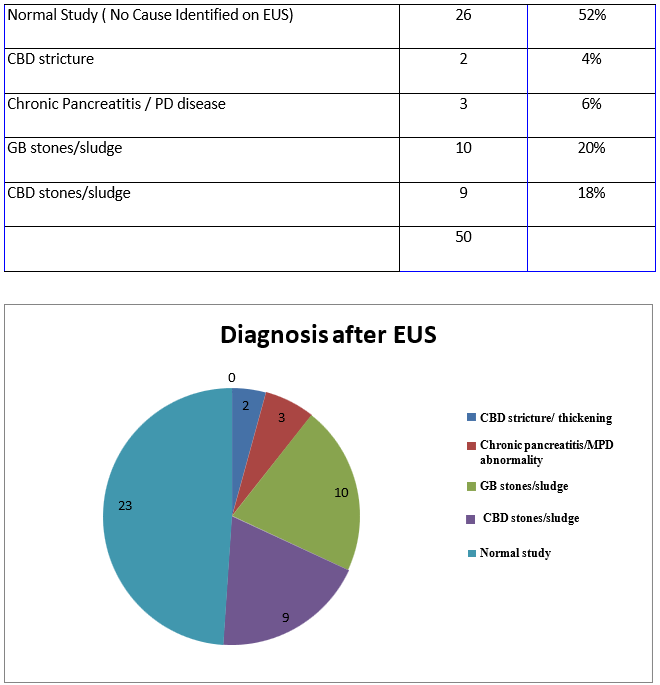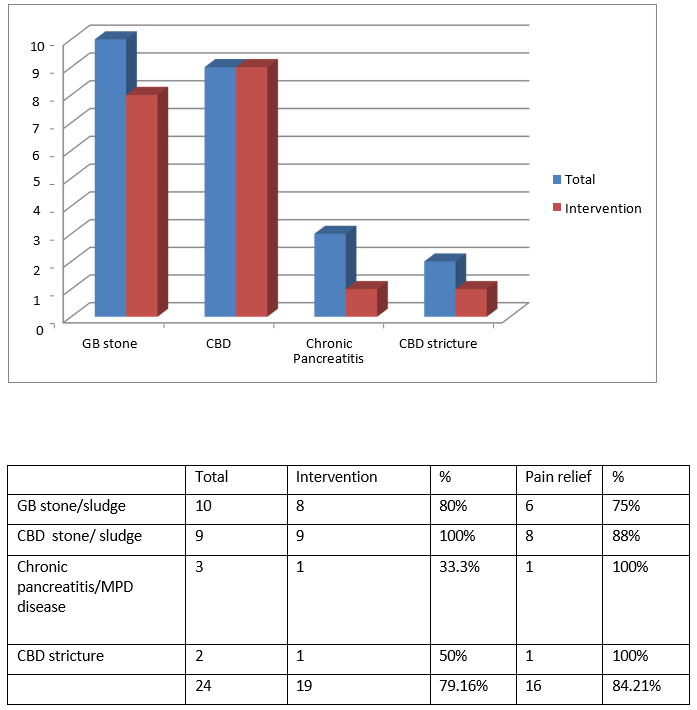Sunday Poster Session
Category: General Endoscopy
P0841 - The Role of Endoscopic Ultrasound in Patients With Chronic Upper Abdominal Pain of Unknown Etiology
Sunday, October 26, 2025
3:30 PM - 7:00 PM PDT
Location: Exhibit Hall

Aakash Batra, MBBS (he/him/his)
Kasturba Medical College of Manipal
Delhi, Delhi, India
Presenting Author(s)
Dhruv Kant Mishra, MBBS, MD1, Syed Uzair, MBBS, MD2, Amit Pandita, MBBS, MD2, Varsha Kachroo, MBBS, MD1, Aakash Batra, MBBS3, Yogesh Batra, MBBS, MD, DM2
1Yatharth Superspeciality Hospital, Delhi, Delhi, India; 2Apollo Hospital, Delhi, Delhi, India; 3Kasturba Medical College of Manipal, Delhi, Delhi, India
Introduction: Chronic upper abdominal pain is a common complaint in gastroenterology, and often remains undiagnosed despite extensive evaluation. This study assessed the utility of endoscopic ultrasound (EUS) in identifying the etiology of such pain and its impact on treatment strategies.
Methods: Fifty patients (19 males, 31 females) with chronic upper abdominal pain lasting over 6 months and no diagnosis despite prior biochemical tests, cross-sectional imaging (CECT or MRI), and endoscopy, were included. All underwent EUS using Olympus linear and radial scopes under general anesthesia. Pain was assessed via a visual analog scale at baseline, 2 weeks, and 6 months after any intervention prompted by EUS findings. A positive response was defined as pain reduction to ≤2 or by ≥50%.
Results: EUS provided a diagnosis in 24 of 50 patients (48%). Findings included gallbladder (GB) stones/sludge in 10 (20%), common bile duct (CBD) stones/sludge in 9 (18%), CBD stricture in 2 (4%), and chronic pancreatitis in 3 (6%). Among the 24 diagnosed patients, 19 underwent therapeutic procedures (ERCP or surgery), and 16 (84.2%) reported significant pain relief at 6 months. Specifically, 8 of 10 patients with GB stones underwent cholecystectomy (75% pain-free), all 9 with CBD stones had ERCP (88% pain-free), and 1 patient each with CBD stricture and chronic pancreatitis underwent ERCP and pancreatic stenting, respectively, with symptomatic relief. Minor transient abdominal pain/distention was noted in 3 cases post-EUS; no major complications occurred.
Discussion: A substantial proportion of patients with unexplained abdominal pain remain undiagnosed despite conventional imaging. EUS demonstrated high diagnostic yield, especially for conditions like CBD stones, GB microlithiasis, and early chronic pancreatitis, where cross-sectional imaging may fail. Early integration of EUS into the diagnostic algorithm can reduce unnecessary tests, expedite diagnosis, and enable timely therapeutic interventions. Its ability to sample lesions also adds diagnostic value.
EUS identified the cause of upper abdominal pain in 48% of patients and facilitated therapeutic interventions in 40%, leading to symptom relief in a majority. These findings support incorporating EUS earlier in the diagnostic workflow for chronic abdominal pain of unknown origin.

Figure: Fig 1: Various causes of chronic abdominal pain in the study group as diagnosed by EUS.
Fig 2: Pie chart depicting the various causes of chronic abdominal pain.

Figure: Fig 3: Bar diagram depicting proportion of diagnosed patients who underwent interventions
Fig 4: Table depicting analyses of pain relief following interventions suggested by EUS
Disclosures:
Dhruv Kant Mishra indicated no relevant financial relationships.
Syed Uzair indicated no relevant financial relationships.
Amit Pandita indicated no relevant financial relationships.
Varsha Kachroo indicated no relevant financial relationships.
Aakash Batra indicated no relevant financial relationships.
Yogesh Batra indicated no relevant financial relationships.
Dhruv Kant Mishra, MBBS, MD1, Syed Uzair, MBBS, MD2, Amit Pandita, MBBS, MD2, Varsha Kachroo, MBBS, MD1, Aakash Batra, MBBS3, Yogesh Batra, MBBS, MD, DM2. P0841 - The Role of Endoscopic Ultrasound in Patients With Chronic Upper Abdominal Pain of Unknown Etiology, ACG 2025 Annual Scientific Meeting Abstracts. Phoenix, AZ: American College of Gastroenterology.
1Yatharth Superspeciality Hospital, Delhi, Delhi, India; 2Apollo Hospital, Delhi, Delhi, India; 3Kasturba Medical College of Manipal, Delhi, Delhi, India
Introduction: Chronic upper abdominal pain is a common complaint in gastroenterology, and often remains undiagnosed despite extensive evaluation. This study assessed the utility of endoscopic ultrasound (EUS) in identifying the etiology of such pain and its impact on treatment strategies.
Methods: Fifty patients (19 males, 31 females) with chronic upper abdominal pain lasting over 6 months and no diagnosis despite prior biochemical tests, cross-sectional imaging (CECT or MRI), and endoscopy, were included. All underwent EUS using Olympus linear and radial scopes under general anesthesia. Pain was assessed via a visual analog scale at baseline, 2 weeks, and 6 months after any intervention prompted by EUS findings. A positive response was defined as pain reduction to ≤2 or by ≥50%.
Results: EUS provided a diagnosis in 24 of 50 patients (48%). Findings included gallbladder (GB) stones/sludge in 10 (20%), common bile duct (CBD) stones/sludge in 9 (18%), CBD stricture in 2 (4%), and chronic pancreatitis in 3 (6%). Among the 24 diagnosed patients, 19 underwent therapeutic procedures (ERCP or surgery), and 16 (84.2%) reported significant pain relief at 6 months. Specifically, 8 of 10 patients with GB stones underwent cholecystectomy (75% pain-free), all 9 with CBD stones had ERCP (88% pain-free), and 1 patient each with CBD stricture and chronic pancreatitis underwent ERCP and pancreatic stenting, respectively, with symptomatic relief. Minor transient abdominal pain/distention was noted in 3 cases post-EUS; no major complications occurred.
Discussion: A substantial proportion of patients with unexplained abdominal pain remain undiagnosed despite conventional imaging. EUS demonstrated high diagnostic yield, especially for conditions like CBD stones, GB microlithiasis, and early chronic pancreatitis, where cross-sectional imaging may fail. Early integration of EUS into the diagnostic algorithm can reduce unnecessary tests, expedite diagnosis, and enable timely therapeutic interventions. Its ability to sample lesions also adds diagnostic value.
EUS identified the cause of upper abdominal pain in 48% of patients and facilitated therapeutic interventions in 40%, leading to symptom relief in a majority. These findings support incorporating EUS earlier in the diagnostic workflow for chronic abdominal pain of unknown origin.

Figure: Fig 1: Various causes of chronic abdominal pain in the study group as diagnosed by EUS.
Fig 2: Pie chart depicting the various causes of chronic abdominal pain.

Figure: Fig 3: Bar diagram depicting proportion of diagnosed patients who underwent interventions
Fig 4: Table depicting analyses of pain relief following interventions suggested by EUS
Disclosures:
Dhruv Kant Mishra indicated no relevant financial relationships.
Syed Uzair indicated no relevant financial relationships.
Amit Pandita indicated no relevant financial relationships.
Varsha Kachroo indicated no relevant financial relationships.
Aakash Batra indicated no relevant financial relationships.
Yogesh Batra indicated no relevant financial relationships.
Dhruv Kant Mishra, MBBS, MD1, Syed Uzair, MBBS, MD2, Amit Pandita, MBBS, MD2, Varsha Kachroo, MBBS, MD1, Aakash Batra, MBBS3, Yogesh Batra, MBBS, MD, DM2. P0841 - The Role of Endoscopic Ultrasound in Patients With Chronic Upper Abdominal Pain of Unknown Etiology, ACG 2025 Annual Scientific Meeting Abstracts. Phoenix, AZ: American College of Gastroenterology.
